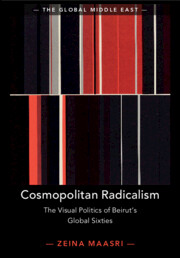Book contents
- Cosmopolitan Radicalism
- The Global Middle East
- Cosmopolitan Radicalism
- Copyright page
- Dedication
- Contents
- Plates
- Figures
- Preface and Acknowledgements
- Note on Transliteration and Translation
- Introduction
- 1 Dislocating the Nation
- 2 The Hot Third World in the Cultural Cold War
- 3 The Visual Economy of ‘Precious Books’
- 4 Ornament Is No Crime
- 5 Art Is in the ‘Arab Street’
- 6 Draw Me a Gun
- Conclusion
- Bibliography
- Index
- Plate Section
Conclusion
Published online by Cambridge University Press: 20 July 2020
- Cosmopolitan Radicalism
- The Global Middle East
- Cosmopolitan Radicalism
- Copyright page
- Dedication
- Contents
- Plates
- Figures
- Preface and Acknowledgements
- Note on Transliteration and Translation
- Introduction
- 1 Dislocating the Nation
- 2 The Hot Third World in the Cultural Cold War
- 3 The Visual Economy of ‘Precious Books’
- 4 Ornament Is No Crime
- 5 Art Is in the ‘Arab Street’
- 6 Draw Me a Gun
- Conclusion
- Bibliography
- Index
- Plate Section
Summary
This book has demonstrated how Beirut emerged in the post-1967 Arab historical conjuncture as a radical node of modernist aesthetic encounter and solidarity in a globally expansive geography of revolutionary anti-imperialism. Central in this cosmopolitan radicalism was the displacement of a Euro-Mediterranean cosmopolitanism by Third Worldist internationalism. This radical aesthetic configuration developed historically in the interstices, overlaps and contentions of transnational printscapes and associated circuits of modernism, linking Beirut to Cairo, Damascus and Baghdad – among other capitals – in a transnational economy of publishing and artistic exchange. These fluid, yet politically entangled, fields of visuality – formed through the mobility of artists/designers, printed matter, political and aesthetic discourses – converged and contended with one another in Beirut’s long 1960s. Their convergence set the conditions of possibility for a radically articulated translocal visuality to emerge in and from Beirut in the aftermath of the 1967 Arab defeat and with the consequent rise of the Palestinian liberation movement on a global terrain of revolutionary politics.
- Type
- Chapter
- Information
- Cosmopolitan RadicalismThe Visual Politics of Beirut's Global Sixties, pp. 243 - 245Publisher: Cambridge University PressPrint publication year: 2020

